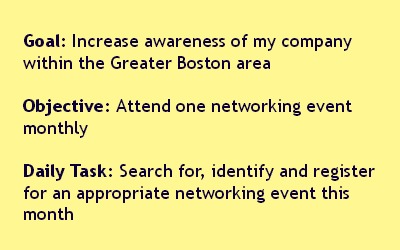
Look — a squirrel!
While we may laugh about losing our focus and flitting from one task to another, it’s no joke.
When asked how they are able to resist distraction and adhere to their top priorities, productivity experts offer a variety of tools and tips. From whiteboards to timer apps, daily to-do lists to customer relationship management software, their common thread is to narrow your attention to maintain focus on the items of most importance to you and your business.
Make a daily list
Sales training expert Brian Tracy advises that it’s critical to plan before plunging in. With our digital age offering ever-present stimuli from myriad directions, maintaining focus on your priorities requires discipline. Use visual support to redirect your attention from these possibly worthy, but non-priority lures, to items of greatest importance to your business. Tracy says,
… every minute spent in planning saves ten minutes in execution. Make a list before you start to ensure that when you do begin work, you will stay focused on that activity that can have the greatest possible consequences for yourself and your business.
The list can take whatever form you wish – a note in your phone, a sticky note (paper or virtual) on your computer desktop, a calendar appointment, or (my tried-and-true) — a daily list prioritized by importance with colored Sharpies.
Be SMART about it
Particularly when anticipating the upcoming start of a new year, you have both business and personal goals that you would like to achieve. As big picture objectives, goals must be broken down into concrete strategies and actionable tactics. From these, you can create daily tasks that are realistic, specific and attainable to move forward on your goals.

Start by breaking down yearly goals into monthly objectives and include strategies to achieve them. Then create tactics to achieve the objectives. Next, break down each tactic into daily tasks. See the example at right.
Note that while the goal is general, the objective and daily task are specific, measurable, attainable, realistic and timely. Ensuring your daily tasks follow these guidelines makes them achievable and leads you toward accomplishing your goals.
The key to productivity: Urgent is not always important
The concept of distinguishing the difference between urgent and important priorities was popularized by both President Dwight Eisenhower and author Stephen Covey in the acclaimed book The Seven Habits of Highly Effective People. The tasks that merit the most attention are those that are both important to reaching your objectives and are time-limited — that is, urgent. A key takeaway from the book:
Important priorities that are not urgent should not be set aside to attend to urgent priorities that are not important.
Read that again. So if something is important, it shouldn’t get pushed aside for something that’s urgent, but not important. In business, a call or text from a client with a “quick request” is a common example of the latter. While we must be responsive to our clients, we must also prioritize our work to focus on the most important items.
Craving a feeling of accomplishment when mired in a complex task, I’m often tempted to shift directions to handle just this quick (urgent) item. The problem with wandering down this path is that one such diversion leads to another, and eventually the day is lost (among the squirrels) … without attention to the items of most importance.
The lesson: Before shifting focus from an important task to one with “great urgency,” consider which task has more importance to achieving your goals.
10 ways to stay focused and increase productivity
Ready to get focused? Choose several of the ideas below and try them for a few weeks. It takes about three weeks to build a new habit.
- End every day by crafting a to-do list of priorities for the following day.
- Visually highlight your day’s top priorities in some way, and reserve your most productive time to accomplish them.
- If a task is not getting done, rather than nudging it from one day to the next, try breaking it down into smaller chunks.
- Check email only at set intervals during the day, or at least shut off your email’s “preview” pane to avoid distraction.
- Create a productive workspace environment: temperature, comfortable seating, good lighting. Remove distracting clutter.
- Begin the day with a healthy breakfast, fresh air and exercise (if possible), to kick-start your brain into action.
- Utilize functionality within your email system to route designated emails (such as those relating to events) directly to a folder and allocate time as appropriate to focus on the folder content.
- Schedule time on your calendar for priority tasks such as business development and responding to emails.
- Use a timer or other audible device to help you to stay aware of time you are spending on a task.
- Do not handle personal email, phone calls or social media during the workday except as you’ve scheduled time to do so. See #9.
Need help keeping focus on your priorities? We work with clients on a project or ongoing basis to maintain momentum toward achieving your goals. Contact us to discuss your needs.
This post was originally published in 2014 and has been updated for relevance and timeliness.



Good one, as always, Nancy. I’m guilty as charged on #3. Thanks for the tip!
I am as well, Jacqueline! I know you authored a downloadable “SMART” goals tool … perhaps you’d be willing to share the link here?